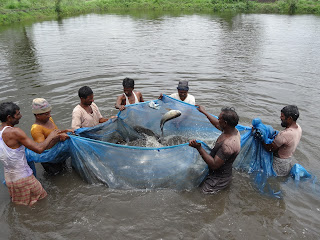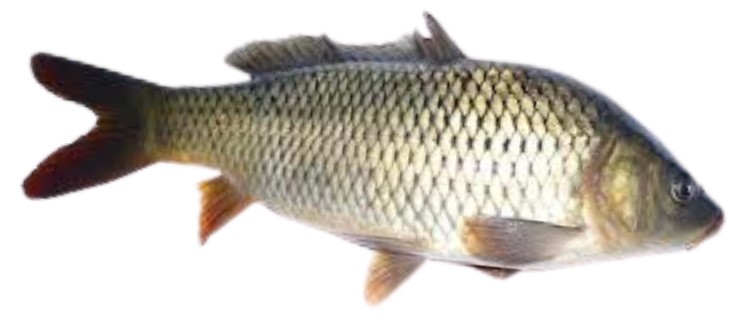Common carp breeding: Cyprinus carpio, popularly known as common carp. It is a fresh water fish and it belongs to the Carp group. It is a Cyprinid fish. It was introduced in India from Srilanka in 1839 & first stalked in Nilgiri Hills in Channai. Today the Common Carp has been distributed not only in the countries of Asia but throughout the world.
In India, Three varieties of Common Carp are avaliable-
1. C. carpio var. specularis (Mirror Carp)
2. C. carpio var. communis (Scale carp)
3. C. carpio var. nudus (Leather carp)
Common Carp Breeding
The sexually matured grown up fish which is raised with special care for breeding purpose is called Brood Fish. The Common Carp sexually matures within a year in warmer climatic condition and easy to breed in stagnant water when the water temperature exceed over 20 °C. However, under good management and under controlled condition, a fish of one year is not bred as they are small in size and such fish produces less number of eggs. Therefore, a fish of three to five years old and big sized fish is selected and specially raised as brood fish, The selected and specially raised fish of big size is only used for breeding purposes. Such big fish produces large number of eggs, fries and fingerlings. For breeding purpose the male and female fish are selected in 2: 1 ratio respectively. ‘Common Carp Breeding’
Generally, the brood fish – male as well as female arc selected strictly on the basis of following characters;
- The body is proportionate,
- No part of body is deformed or abnormal,
- Yhe scales are uniformly distributed throughout the body,
- Lateral lines remains single and continuous line along the body.
- The fish which grows fast and
- The fish is free from parasite and disease. ‘Common Carp Breeding’
Common carp are relatively easy to breed in captivity, making them a popular choice for aquaculture. There are two main methods for breeding common carp- natural spawning and induced spawning. ‘Common Carp Breeding’
Natural spawning
This method relies on the natural breeding behavior of the fish. Broodstock (mature male and female carp) are selected and placed in a breeding pond. The pond should be well-vegetated with plants such as hydrilla or vallisneria, as these provide spawning substrate for the eggs. The water temperature should be between 18-22°C (64-72°F). The carp will spawn naturally when the conditions are right, typically during the spring or summer. After spawning, the adult carp can be removed from the pond. The eggs will hatch within a few days, and the fry can be raised in a separate pond until they are large enough to stock in a grow-out pond.

Induced spawning
This method involves using hormones to stimulate the carp to spawn out of season. This is often done in hatcheries where a controlled environment can be maintained. Broodstock are injected with hormones, such as carp pituitary extract, to trigger ovulation in females and spermiation in males. The carp are then stripped of their eggs and milt, which are mixed together to fertilize the eggs. The fertilized eggs are incubated in hatching tanks until they hatch. The fry are then raised in nursery tanks until they are large enough to stock in grow-out ponds. ‘Common Carp Breeding’
Preparation of Breeding Pond
As the water temperature exceeds 20 ° C, preparation of breeding pond is carried out. The breeding pond is left dry before the breeding season. During this lime the repair of the pond’s dike, inlet and outlet are undertaken. About 10 Kgs. lime is broadcasted throughout the pond.
At the same time a thin stripes of bamboo are prepared and good quantity of terrestrial grass or fibre of Coconut or synthetic fibre are collected. The thin stripes of bamboo are interwoven in such a way that a 4′ × 6′ sized mat is made. On such mat long green grasses or fibre of Coconut or synthetic fibre are placed to form a mattress and on lop of such grasses or fibre another bamboo mat is placed and tied. The mattress of green grasses or fibre is called kakabon. A number of such kakaboons are prepared and stored under shade until the breeding season starts. ‘Common Carp Breeding’
With the rise of water temperature, the breeding pond is filled up with fresh water after screening at morning time. A number of kakaboons are fixed horizontally on the vertical bamboo pegs around the shore of the breeding pond. Generally, the kakaboons are fixed at or around 3′ 6″ – 4″ high from the bottom of breeding pond and 4″ -6″ below the surface of the water. After filling the water, the breeding pond is left for whole day, so that the silt settles down and the water remains clear and warmer too. ‘Common Carp Breeding’
- Common carp (Cyprinus carpio) generally breeds in confined water.
- Spawning takes place in shallow marginal, weed infected areas from January to March and from July to August.
- Common Carp is also observed to breed round the year.
- Controlled breeding of common carp is conducted to achieve better spawning and hatching. ‘Common Carp Breeding’
- A set of selected brooders contains one female and two males
- In order to ensure successful spawning sometimes the female fish is injected with pituitary gland extract at a low dose 2 to 3 mg / kg body weight.
- Freshly washed aquatic weeds (Hydrilla, Najas, Eichhornia etc) are uniformly distributed inside the hapa. These aquatic weeds act as egg collections.
- The quantity of weed used is roughly double the weight of the female introduced. Each weed attached with 40,000 to 1,00,000 eggs are distributed into a single hatching hapa.
- After 4 to 5 days the weeds are taken out carefully. ‘Common Carp Breeding’
Breeding
With all the above preparations, the breeding pond is ready to receive specially raised male and female brood fish. First, the female pond is netted and well developed females are selected on the basis of bulged stomach due to eggs, soft belly and reddish and swollen vent. Two females of about 3-5 kg. body weight are selected for a breeding pond of 1 – 2 kanal. Similarly, the male pond is netted and four males are selected. The selected males ooze out white milt even with a gentle pressure on belly. The selected males and females are released in well prepared breeding ponds at evening. ‘Common Carp Breeding’
The fresh water, higher water temperature and kakaboons stimulate the long segregated males and females of Common Carp for breeding. The male starts escorting the female fish within a couple of hours of release in the breeding pond. By next morning, the male starts chasing the female and mating process starts with flashing of water and the male starts rubbing its body with female. The male fish starts driving the female towards the kakaboon where the female starts laying out the eggs and simultaneously the male oozes out the milt containing spermatozoa which fertilises the released eggs. The fertilisation lakes place outside the body. The eggs in which the spermatozoa gets in are fertilised, where as others remain unfertilised and they get spoiled. The Common Carp’s eggs are sticky in nature, so the eggs slick to the grasses or fibres of kakaboons. ‘Common Carp Breeding’
The mating process of Common Carp continue for hours until the female is not exhausted with eggs. After few hours of mating process, the pond turns out calm and quite. At this stage the exhausted male and female need be provided with supplementary food at one end of the pond, otherwise, the exhausted and hungry brood fish may start eating their own eggs. Therefore, the exhausted brood fish are either netted out gently from the breeding pond or they are led with supplementary feed. ‘Common Carp Breeding’
With the fertilisation of the egg, the egg starts swelling and embryo starts developing In due course of time the developing embryo attains eyed stage. By this stage the brood fish need to be netted out from breeding pond, if nursing of the fries is aimed to be carried out in the same pond. But if the hatching and nursing of the fries is aimed to be carried out in other pond theft the kakaboons with eyed egg embryo are transferred either early in the morning or late evening to specially prepared nursing pond, where the egg hatches out to hatchlings and the hatchlings grow to fries and fingerlings. ‘Common Carp Breeding’




